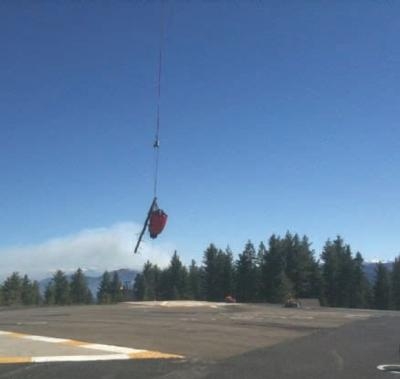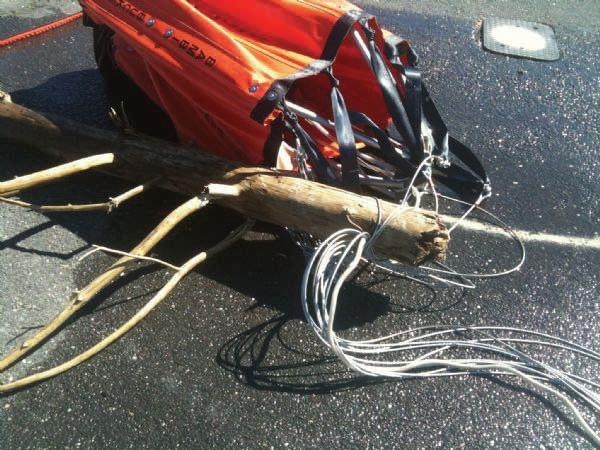Thu, Aug 18, 2011
Cautioned To Use Care When Selecting Sites For Water
Loading
As fire season progresses in the West, many rivers and streams
are flowing at higher than normal rate for this time of year,
according to the U.S. Department of the Interior and U.S. Forest
Servic.. Those that are flowing near normal appear to have a
significant amount of debris from earlier flooding. With the high
water flow and debris, the agencies say thorough risk assessments
need to be conducted on dip sites prior to commencing
operations.
Dept. of the Interior Photo

A Bell 212HP performing bucket operations with a 150 foot
longline (SAFECOM 11-508) caught a log in the bucket cables. The
assistant helicopter manager and pilot had scouted the area for dip
sites and determined the main river was flowing too fast. Smaller
streams with pools and a lake were selected as optional dip
sites.
In the after action review the unit noted that the pools
selected were twice as large as normal with faster running water in
and out of the pool. This caused some concerns; fast water caused
the bucket to roll back through itself tangling the cables, and
there were known to be logs and other hazards under the water
surface that were not easily visible to the pilot. The lake water
was so high that trees and shrubs along the shoreline were well
below the high-water line and roots or snags were not easily
visible.
Dept. of the Interior
Photo

Recommendations from the two agencies include:
- Use local knowledge for dip site selection.
- Utilize dip site managers whenever possible and ensure they
have radio contact.
- Helicopter managers need to discuss with the pilots their
comfort level with dip sites and if improvements are needed.
- Conduct thorough reconnaissance; include a broader look at the
water area so all potential obstacles are addressed and ensure
safety circle compliance if descending below canopy.
- Define parameters for dip site acceptability based on your
assessment of the risks from winds, debris, swift water, etc.
Ensure all personnel using the dip site understand and operate
within those parameters.
- Look for pools near the sides of the rivers or streams where
flow rate is lower.
- Carefully evaluate pools that are developed upstream from
debris build-up.
- In extremely high water conditions ensure that the dipsite is
free of debris and the and the bucket is kept away from the water
inlet and the outlet where debris may have settled.
- Control the bucket depth throughout the dip cycle, do not allow
the bucket to sink below the waterline to the point that obstacle
avoidance cannot be assured.
- Consider alternatives to the risk of fast water (i.e. setting
up folding tanks, pumpkins, etc.)
More News
The Industry Continues to be Rocked By Some Questionable Operations Recent investigations and a great deal of data has resulted in ANN’s SportPlane Resource Guide’s rep>[...]
Make Sure You NEVER Miss A New Story From Aero-News Network Do you ever feel like you never see posts from a certain person or page on Facebook or Instagram? Here’s how you c>[...]
Visual Approach Slope Indicator (VASI) An airport lighting facility providing vertical visual approach slope guidance to aircraft during approach to landing by radiating a directio>[...]
Airport Marking Aids Markings used on runway and taxiway surfaces to identify a specific runway, a runway threshold, a centerline, a hold line, etc. A runway should be marked in ac>[...]
Aero Linx: The Skyhawk Association The Skyhawk Association is a non-profit organization founded by former Skyhawk Pilots which is open to anyone with an affinity for the A-4 Skyhaw>[...]
 Unfortunate... ANN/SportPlane Resource Guide Adds To Cautionary Advisories
Unfortunate... ANN/SportPlane Resource Guide Adds To Cautionary Advisories ANN FAQ: Turn On Post Notifications
ANN FAQ: Turn On Post Notifications ANN's Daily Aero-Term (04.29.24): Visual Approach Slope Indicator (VASI)
ANN's Daily Aero-Term (04.29.24): Visual Approach Slope Indicator (VASI) ANN's Daily Aero-Term (04.28.24): Airport Marking Aids
ANN's Daily Aero-Term (04.28.24): Airport Marking Aids ANN's Daily Aero-Linx (04.28.24)
ANN's Daily Aero-Linx (04.28.24)




